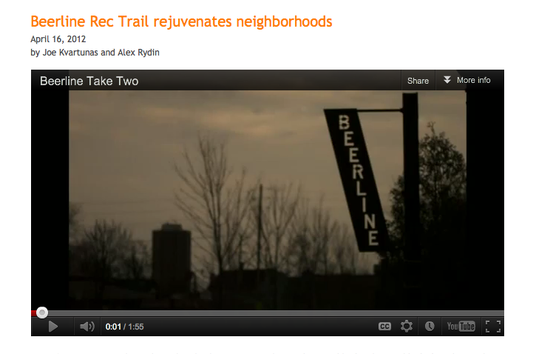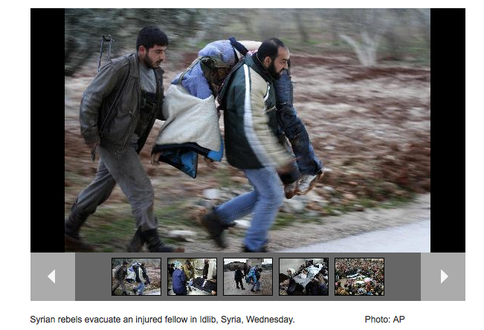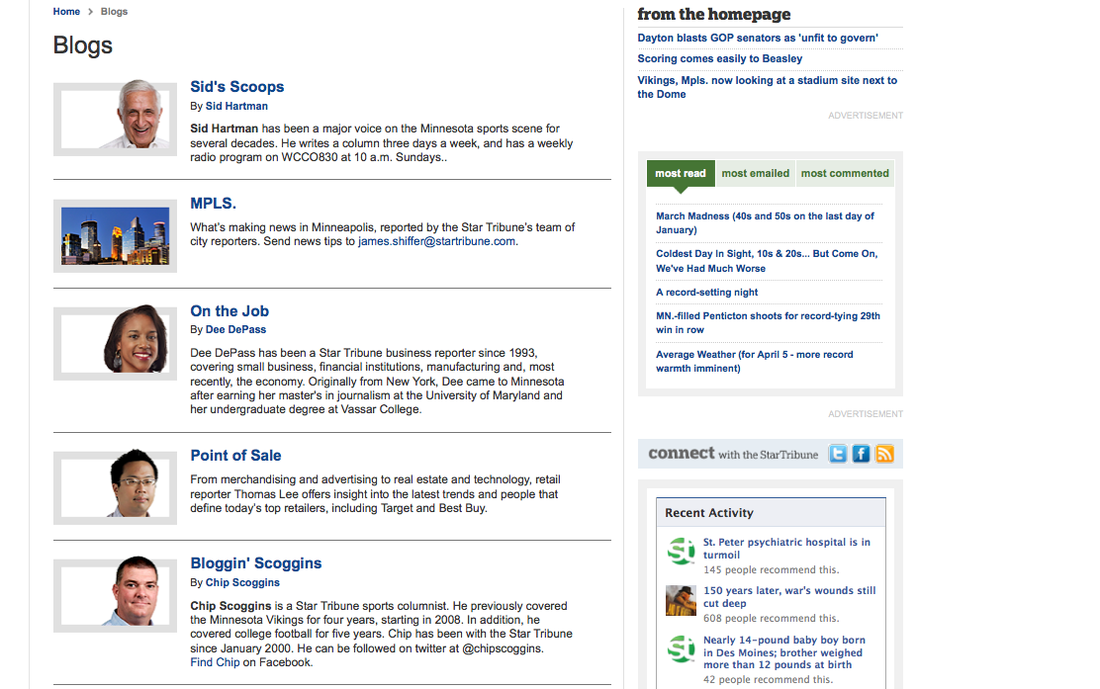 On April 12 my journalism class watched a Poynter video on natural sound recording. The video lecture – entitled "Natural Sound Packages: Video Storytelling Without Reporter Narration" – featured loads of useful advice on collecting audio and getting soundbites that are great for your story. It was a fantastic informative piece that I learned a lot from, I just wish I had seen it sooner.
For most of the semester I have been working on two projects that heavily involve this type of audio narration. One, which will be posted later on this site, has yet to be completed. The other was just published by the Milwaukee Neighborhood News Service, who I have reviewed in the past. I am very proud of my work on the Beerline Trail story that I did with Alex Rydin, but there were certainly some hiccups that could have been avoided had I known the ins and outs of how to go about collecting audio for a story like this beforehand. A lot of what was talked about in the Poynter Lecture was obvious, but it seems it was the obvious things that tripped me up. For example, one of the very early things that was talked about in the lecture was that you need to find a great storyteller. When Alex and I began the story our primary source of information was the project manager Chris Grandt. Mr. Grandt was knowledgeable and excited about the project, but he wasn't necessarily the best storyteller, in my opinion. He was more interested in facts, cold hard math. We did find a fantastic storyteller in Mario Costantini, but he didn't have the knowledge of the project to be able to drive the story forward. In a perfect world Mr. Grandt and Mr. Costantini would be the same person, and Alex and I would have gotten the best audio possible. The problem is that we never were able to get someone who could give us the basics. Mr. Costantini didn't really know them, and Mr. Grandt was, at times, so detail oriented that the simple basics weren't an option for him. Of course, this may also have been my fault. I rediscovered during the lecture that asking the right questions is vitally important, which is something I did not always do. Going into the interviews I had done my research like any good journalist, and was more interested in the detail oriented questions. I never asked the big picture "So what" question right from the beginning, which would have mad mine and Alex's lives a whole lot easier when it came to editing time. Now don't think that I ruined our story with my mistakes, because I certainly didn't. My story came out very well in the end. I just managed to make my life unnecessarily difficult for a few weeks, which I don't plan on doing again.
Today the Star Tribune posted this editorial of American war correspondent Marie Colvin's death. She was killed in Syria yesterday along with French photographer Remi Ochlik. Her death, the result of a Roadside bomb, comes days after the death of New York Times reporter Anthony Shadid, who died due to complications from an asthma attack. Colvin was a correspondent for Britain's Sunday Times who covered wars all around the world, including Kosovo, Chechnya, Sierra Leone, Sri Lanka (where she lost an eye) and around the middle east. Recently she covered much of the Arab Spring uprisings around North Africa. She was in Syria covering the siege of Homs when she was killed. I find this event to be very important because of who Colvin was. She was, in my mind, the pinnacle of what young journalists like myself should strive to be. She had a commitment to the story that led repeatedly led her into war zones and conflict ridden areas. Even in the days before her death she was doing reports for BBC and CNN. Colvin had sneaked into the city of Homs only days before using an old smugglers route and was stationed in the heavily shelled Baba Amr district of the city which is home to roughly 28,000. When the majority of western reporters left Homs because of the danger, she chose to stay believing that the attack on Homs was too important for the world not to know about. She displayed all of the qualities that we hope to find in our members of the media.
The reason I wanted to comment on this editorial is twofold. 1) It is the ONLY coverage on her death I could find today on the Strib website. 2) It was written by an editor for the Washington Post, not a member of the Star Tribune.
Now I understand that Colvin had next to nothing to do with the Strib, or Minnesota as a whole for that matter, but she was one of the more important figures in journalism and I am surprised that there is no obituary for her. I don't believe that the Strib loses credibility for not publishing an obituary for her, because she was far from a household name. I do, however, believe that they are remiss for not publishing an obit on someone who was such an important figure from the industry.
With Colvin passed on, I hope that there will be other journalists to take her place soon. The world needs more journalists with the drive, belief in what they are doing of Marie Colvin.
I'll admit it. I'll come right out and say it. I have been pretty hard on the Star Tribune for most of my beat posts. I criticized their Superbowl coverage, called their blogs repetitive, and said they didn't provide enough original content in their State of the Union coverage. But it seems the fine men and women of The Strib have gotten high marks from me this week, because I really have nothing to complain about with their photos. I have commented before how visual the site is. It has graphics and photos for almost every article. But now that I am finally talking about photos specifically I get to rave on and on about how great my beat is, rather than give my typical "Oh they were pretty good but nothing really spectacular is here." Looking solely at The Strib's photo galleries, (because I have talked about the photos and graphics in articles in previous blog posts) I was endlessly impressed with the work being done in the Twin Cities.  One gallery in about the violence in Syria particular caught my eye. Obviously the uprisings and violence in the Middle East and North Africa have been a major news story for more than a year now. So when I saw this among the listing of galleries for today I was immediately drawn to it. Naturally, pictures taken in a war zone have great impact and emotion. One image (shown at the left) caught my eye more than the others, however. The image shows a man carrying a wounded other while another follows them with an assault rifle. This is a powerful impactful picture. There is a lot going on here. The movement of the picture gives the viewer a sense of urgency. This coupled with the body obviously gives the picture a very dark mood. The gun and the background grant a sense of place to the image. We see the assault rifle and the trees in the background and we realize that this is a photo being taken in a war zone, but not in a major city. This is just one of a group of very powerful photos. The Strib has many other very good galleries. They post photos for major local events, such as the Minnesota caucuses, as well as local sports teams' games. In all there were 10 photo galleries posted today alone. I am very very impressed with the photography work in the Strib.
As a Patriots fan it was difficult and frustrating for me to go through and revisit that game. But to be perfectly honest, there wasn't a whole lot of punishment I needed to suffer. The coverage on the site was good, but nothing truly exceptional. The articles posted about the game offered no exceptional analysis. "Welker should have caught that ball," and "Eli Manning is an Elite quarterback now" were common lines among the writers and bloggers of the site. I don't want to take anything away from the coverage that the site did have, but you were definitely aware that this was a site catering to a regional market. The pregame coverage was pretty good as well. There was one article in particular by Dan Wiederer which summed up the leading story heading into the game. The article talked about how winning a Super Bowl validates greatness in a quarterback. This story line was all over the place before the game. Preseason someone asked Eli Manning, the quarterback of the New York Giants, if he considered himself to be an "elite" quarterback. Six months later that question appears to have been answered in the affirmative. There were also the few articles that come out every year that manage to be both about the Super Bowl, and have absolutely nothing to do with the game. There were obviously the the articles on the ads were prominent. Everyone enjoyed talking about the overuse of celebrities and how they ruined otherwise funny commercials (see Mark Cuban in the Skechers ad). People were also talking about musical artist M.I.A. flipping the bird to the camera during the halftime show. You'd think we would have learned our lesson with the Timberlake Janet Jackson incident of 10 years ago. This of course will cement over-the-hill classic rock acts for the next 10 years. Why can't we just get a cool artist like the Black Keys or The Strokes to do the halftime show. They will have no interest in showing their breasts or flipping the bird to create headlines, and the show probably won't be awful.
You certainly can't criticize the Star Tribune for a lack of blogs. Actually the website of the Minneapolis based newspaper commonly referred to as "The Strib" boasts 44 different blogs on a wide variety of subjects. As I looked through the website I was able to find out that every section has its own blog, and most of them have more than one. In fact, every section except politics, which is stuck with only Hot Dish Politics, has more than one blog. As my count went, the section with the most blogs was Sports, providing 19 almost different blogs commenting on everything form the Minnesota Twins (5 blogs) to combat sports (one blog). The Local News and Lifestyle sections each provided nine different blogs while the Business section came in with six. The Arts & Entertainment section was able to bring 2 blogs to the party, but one of them was solely concerning books and literature, which left the other to cover music, movies, television, museums, etc. My first reaction upon seeing so many blogs was "Great! Perfect! Lots of differing viewpoints and and specific beats. This is fantastic." However, the reality was far from the dream. One problem, which surfaced most often in the sports section, Is that much of the information becomes repetitive. For example, with most of the 19 sports blogs attempting to report locally, everyone (except for Suzanne Solheim who hasn't updated her blog since November) commented on the Joel Zumaya signing, all saying it would create a great bridge between the starters and Matt Capps, the closer. (They Are all wrong by the way. Zumaya hasn't been healthy enough to make a positive impact on a team since 2006, and this year won't be any different. Of course on a $900,000 contract, its not exactly a bad signing if he doesn't work out, but I digress.) Of course this is not the story for every section. Business and Local news have good originality through each individual blog, but some of the blogs become nothing more than a place for columnists from the print edition to become long winded. In my opinion thebest blog published is the previously mentioned Hot Dish Politics. With seven contributors in Minnesota and one on the ground inside the beltway, this blog is able to provide the best coverage of any of the blogs on the website.
As an assignment for my beat for Journalism 1550, I was tasked to cover the coverage of the State of the union Address by the Star Tribune out of Minneapolis, Minn. Unfortunately I did not become aware of said assignment until the next morning, so I was unable to analyze the analysis during the speech as I normally would have tried to do. The Star Tribune is a regional paper, and thus will not provide the comprehensive coverage that a national news source would provide. So if you are interested in comprehensive political dissection of every word, you are likely better off going to a paper like The Washington Post. That is no slight to the Tribune, though, as their coverage was quite good. The coverage that the Tribune posted online was absolutely comprehensive enough to leave most readers satisfied. They posted well crafted articles with a variety of viewpoints on the speech and its surrounding story lines. However, most of their content was borrowed from other news sources, such as the Associated Press, New York Times, and – as can be seen in the byline in the screen shot above – The Washington Post. The original content that was posted by the Tribune was good. Notably, their Fact Checker piece was comprehensive and fair. Overall the content was interesting and unbiased. I found one of the most interesting stories that was reported around the address was not on the speech at all. Apparently in the hours before the speech, the Secretary of Defense Leon Panetta oversaw a mission to rescue two hostages in Somalia. he president can even be seen congratulating Panetta on a job well done as he was making his way up the aisle to the podium. Overall, coverage was good. Lifting so many articles from other news sources was probably necessary for a regional newspaper like the Tribune. I give it high marks provide accurate, timely and comprehensive coverage of such an important national event.
To be fair, if I had not been assigned the Star Tribune website for my beat in my journalism class, I would likely never look at it unless there was a major event happening in the Twin Cities area. That being said, I have liked what I have seen so far from the Tribune's website. Structurally, the website is very well put together. There is a lot of graphic content which makes the site easy to look at, and the headlines are all large or bolded. The trending stories across the top (where it says "NEWS NOW") is something that a lot of sites are using. The headlines are relatively large, making them easy to read.
Further down (below where the screenshot ends) there are more links to different multimedia. There is a box for latest videos, and each section has a box with links to its top stories, and there are links to the paper's top columnists and bloggers. Everything has is ordained with a picture making the entire thing easy to deal with as a reader.
This is really something I love about the site. I absolutely hate it when a website crushes you with text on its homepage. The New York Times does this on their website. All of their front page articles have the first few sentences underneath the headlines and its set up in columns so that the whole thing appears as if they are trying to make it look like the newspaper on line. On top of that all the links to different sections are in small type along the side, rather than in bold and color across the top. The Times site has a bit of an overwhelming feel to it and that is not how it should be. The Star Tribune does a very good job of making site navigation easy.
The other important part of a news website is obviously content. The folks at the Star Tribune do a very good job in this department. The reporting, as far as I can tell, is thorough and the writing is clear. The focus in the news section is more local than what you would get with a major news website, which is absolutely perfect for the market that the Tribune is appealing to. The readers aren't going to the Tribune to see how the President is handling the opposition over the latest bill, they are looking for news on how the local school board's recent ruling will affect their children.
The sports section is very large,which is what you expect from a newspaper in a major metropolitan area with competitive teams.
All in all my first impressions have been very good. I expect to see good things coming out of Minneapolis this semester.
|









 RSS Feed
RSS Feed